|
|
|
Sort Order |
|
|
|
Items / Page
|
|
|
|
|
|
|
| Srl | Item |
| 1 |
ID:
132808
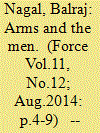

|
|
|
|
|
| Publication |
2014.
|
| Summary/Abstract |
The five pre-1998 nuclear powers have matured their Nuclear Command and Control Structures, and Nuclear Forces Structures (NFS) over a period ranging from 70 years for the US to 50 years for China.
The Cold War arms race created thousands of systems for command and control or functioning of military forces. The C4ISR systems deployed or under development provide 24 hours continuous surveillance of each other's areas/offensive weapons, detect movement of strategic systems or change of deployment patterns and allied/linked systems. The command and control of these powers are well developed, with state-of-the-art electronic systems to function under NBC conditions. The command centres are located in deep underground hardened shelters, capable of withstanding nuclear attacks, functioning 24x7.
|
|
|
|
|
|
|
|
|
|
|
|
|
|
|
|
| 2 |
ID:
132813
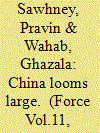

|
|
|
|
|
| Publication |
2014.
|
| Summary/Abstract |
India's national security, especially its defence preparedness against Pakistan and China, with whom it has disputed border, is passing through a disturbing phase. Pakistan continues with cross border terrorism into Jammu and Kashmir, while China infringes upon Indian land and air space from Ladakh to Arunachal Pradesh at will. Both have made a mockery of the military-held lines with India.
Speaking in Parliament during the recent budget session, defence minister Arun Jaitley expressed satisfaction regarding the two disputed borders. According to him, the Indian Army has minimised infiltration across the Line of Control and terrorism in the hinterland with a mix of good anti-infiltration deployment, monitoring and surveillance means, and the fence. Chinese intrusions, he said, are because of differing perception of the disputed border by the two countries.
Do we want better detection and elimination of terrorists in Kashmir, or do we want to compel Pakistan to stop infiltration? If India does not intrude into Chinese land, why should China do this to India regularly?
India seems to have accepted low defence thresholds against both neighbours. This is worrisome. If Pakistan and China are not deterred by India and its military power, especially boots on the ground, will India's two-front war strategy work to compel them? Why is India spending nearly USD 49 billion annually, which excludes defence pensions and nuclear weapons capability, on defence when it appears blunted? Is there a way out for India without going to war with either or both?
India needs a transformation of its national security and defence thinking. It must know that China rather than Pakistan is its irreconcilable adversary, and the disputed border with China is India's singular core concern which impedes India's rise. Once this is grasped, a new approach to policy-making and warfare would emerge. China could be balanced by a political-military methodology, while peace could be made with Pakistan. India's warfare practised so far would alter drastically. With China as the main adversary, India would no longer be preparing to fight the last war better. With more domains like space, cyber, ballistic and cruise missiles, irregular warriors (terrorists) and nuclear weapons added to the conventional combat on land, air and sea, India will need different higher defence organisation and higher strategic organisation from those proposed so far. All this can be done without raising either annual defence allocations or ringing alarm bells in the region.
|
|
|
|
|
|
|
|
|
|
|
|
|
|
|
|
| 3 |
ID:
132815


|
|
|
|
|
| Publication |
2014.
|
| Summary/Abstract |
Farnborough: For those who saw the heady years of 2008-2011, it is a bit of a shock to see India reduced to the periphery of the global defence and aerospace market. At Farnborough International Airshow (FIA) 2014, it seemed that India had fallen off the radar of the global companies, the majority of whom now have waning interest in the country, having invested both time and money over the last almost a decade without commensurate returns.
Of course, India is an important market because of its sheer size, but it has once again gone in the 'market in the making' mode. There is no immediacy to the existing programmes and those in the pipeline are likely to stay there for a while. That the global industry has realised this after the euphoric four years when India used to be the toast of the international shows was more than obvious at FIA, amongst the biggest aerospace spectacle in the world.
|
|
|
|
|
|
|
|
|
|
|
|
|
|
|
|
| 4 |
ID:
132809
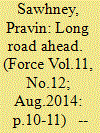

|
|
|
|
|
| Publication |
2014.
|
| Summary/Abstract |
General Bikram Singh took over as the chief of army staff (COAS) on May 31 under extraordinary circumstances. His predecessor, General V.K. Singh took exceedingly much from the army as its chief than he gave back to it. He publicly pitted the army against the government and took the latter to court on the issue of his age for which he alone was responsible. More than blaming a few senior officers for wrongdoings, he floated the impression that most of the officer class had gone to the pits. Towards the fag end of his tenure, he informed the nation that the army lagged behind in terms of modernisation, something he should have done at the beginning of his innings. He gave so many insinuating media interviews that he sounded like a stuck record. While certainly an upright officer, he used the institution to exhaustion. So much so, that it would be long before the army recovers enough to look normal.
|
|
|
|
|
|
|
|
|
|
|
|
|
|
|
|
| 5 |
ID:
132812
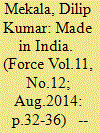

|
|
|
|
|
| Publication |
2014.
|
| Summary/Abstract |
Despite the high spending on defence, India has been struggling to develop its own indigenous manufacturing base. Almost 70 per cent of the equipment is imported from various countries, making it the biggest importer of defence technology in the world. In a recent statement to the Parliament, defence minister Arun Jaitley said, "Imports are being resorted to take care of urgent requirements of equipment, weapons and other products required for defence for which domestic production is non-existent or inadequate". In other words, he agreed that the indigenous industry has been incapable of producing majority of defence equipment.
|
|
|
|
|
|
|
|
|
|
|
|
|
|
|
|
| 6 |
ID:
132811
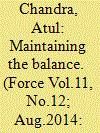

|
|
|
|
|
| Publication |
2014.
|
| Summary/Abstract |
The most potent of the fighter upgrades being planned for the Indian Air Force (IAF) is the Mirage 2000 upgrade being performed by Dassault, Thales and Hindustan Aeronautics Limited (HAL). The upgrade will extend the operational performance of the IAF's existing Mirage fleet, delivering a coherent platform system combination for the next 20 years.
According to a Thales spokesperson, the upgrade will see the integration of new capabilities, "These include longer-range detection across the entire spectrum, improved tactical situation awareness, longer-range weapon firing against multiple simultaneous targets, weapon stealth and extended operating envelope with the capability to engage ground targets while countering airborne threats."
|
|
|
|
|
|
|
|
|
|
|
|
|
|
|
|
| 7 |
ID:
132810
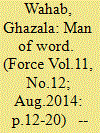

|
|
|
|
|
| Publication |
2014.
|
| Summary/Abstract |
Smile comes easily to Admiral Robin Dhowan. And it reaches his eyes just as quickly as it touches his lips, forcing his interlocutor to smile too. With ambience such as this, it requires super-human effort to veer the conversation towards any subject less than pleasant. How does one judge a person, or weigh his assertions if he smiles all the time and his eyes twinkle so often?
|
|
|
|
|
|
|
|
|
|
|
|
|
|
|
|
| 8 |
ID:
132814
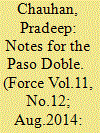

|
|
|
|
|
| Publication |
2014.
|
| Summary/Abstract |
In the run-up to the forthcoming historic visit of Prime Minister Narendra Modi to the US in September, it seems particularly pertinent for this edition of 'Maritime Meanders' to amble through some of the past and present (and even discern some element of the future) of the maritime component of the India-US defence relationship.
|
|
|
|
|
|
|
|
|
|
|
|
|
|
|
|
| 9 |
ID:
132816
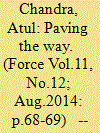

|
|
|
|
|
| Publication |
2014.
|
| Summary/Abstract |
In what can only be termed as a welcome move, aerial connectivity for India's hinterland is receiving a push with the new government. In its first budget, the government announced: "Plans to build 200 low-cost airports in the next 20 years to connect Tier-II and Tier-III cities." Adding that it "also plans to construct 15 additional airports under the Greenfield Airport Policy by identifying the most suitable low cost viable model. Budgetary support of Rs 50 crore has been provided to Directorate General of Civil Aviation (DGCA) to pursue their plan scheme.
|
|
|
|
|
|
|
|
|
|
|
|
|
|
|
|
| 10 |
ID:
132819
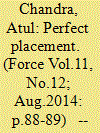

|
|
|
|
|
| Publication |
2014.
|
| Summary/Abstract |
Sriharikota: The Indian Space Research Organisation's (ISRO) Polar Satellite Launch Vehicle, PSLV-C23, confirmed its status as the country's workhorse launch platform, when it completed a flawless launch into space and orbit placement of five satellites on June 30. On hand to witness ISRO's performance was Prime Minister Narendra Modi who was visibly pleased during and after, what was a textbook launch. He also asked the Indian space community to develop a South Asian Association for Regional Co-operation (SAARC) satellite that provides a full range of applications and services to all our neighbours.
|
|
|
|
|
|
|
|
|
|
|
|
|
|
|
|
| 11 |
ID:
132821


|
|
|
|
|
| Publication |
2014.
|
| Summary/Abstract |
The Indian Air Force (IAF) conducted Exercise Garuda-5 with the French Air Force (FAF) in Jodhpur in July this year. The exercise saw the IAF fly its Su-30 air dominance fighter, MiG 21 Bisons and MiG 27 ground attack aircraft while the FAF brought in its Rafale multi-role fighter. The very mention of the name Rafale got the media excited, courtesy the long pending decision of India's acquisition of a Medium Multi Role Combat Aircraft (MMRCA); the increased media interest also pointed to a major aim of such international air exercises, which is to showcase and increase the visibility of a nation's military products with an aim to hardsell it.
|
|
|
|
|
|
|
|
|
|
|
|
|
|
|
|
| 12 |
ID:
132818
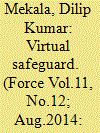

|
|
|
|
|
| Publication |
2014.
|
| Summary/Abstract |
In the backdrop of high expectations set by Narendra Modi before the General Elections, the government's inaction in the field of cyber security seems to be extremely disappointing. It is no secret that India has been far behind in enforcing a comprehensive policy related to cyber security. Last year, the National Cyber Security Policy was released by the then UPA government which listed a broad overview of the plan of action, but it failed to provide the roadmap for implementation. All eyes are now on the National Security Advisor Ajit Doval to see how he would deal with the issue.
|
|
|
|
|
|
|
|
|
|
|
|
|
|
|
|
| 13 |
ID:
132820
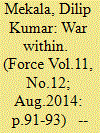

|
|
|
|
|
| Publication |
2014.
|
| Summary/Abstract |
If asked, ministry of home affairs (MHA) downplays this, but India's internal security battle is being fought by the most disgruntled, demotivated paramilitary troops. The reason for such a shameful situation is the inaction by the ministry in resolving the grievances of the forces. FORCE has interacted with many officers below Commandant rank deployed in operational positions, who claim that the weak leadership is to be blamed entirely for the situation.
MHA has often painted a rosy picture that all is well within the forces. Even in the Parliament recently, while explaining the reason behind huge number of Central Reserve Police Force (CRPF) officers quitting their jobs, the ministry stated that it is "normal and acceptable". From 2009 to 2012, in the CRPF alone 16,523 officers quit their jobs. What is more baffling is the casual tone of reasoning that the ministry has provided in justifying this issue. "The causative factors in most of the cases were mainly found to be various personal and domestic reasons… Some personnel seek voluntary retirement to enjoy a static life as well as pensionary benefits after completion of 20 years of regular service," said minister of state (home), Kiran Rijiju.
What MHA conveniently did not state in the reply to the Parliament is that most of the officers who quit their jobs were troubled by their uncertain career progression - they believed that no due credit was given for risking their lives in conflict zones. Poor salary also caused a lot of dissatisfaction. Presently, there are at least 10,000 officers from all paramilitary forces fighting various legal cases in the courts, thus proving that all's not well within.
|
|
|
|
|
|
|
|
|
|
|
|
|
|
|
|
| 14 |
ID:
132817
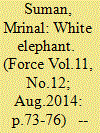

|
|
|
|
|
| Publication |
2014.
|
| Summary/Abstract |
The budget presented on 10 July 2014 has been called pedestrian, lacklustre and devoid of any innovative initiative by different critics. Some have gone to the extent of describing it as a 'budget-without-tears', wherein a token allocation of Rs 100 crore has been made to each and every promise made in the party manifesto.
However, one curious provision of the budget has escaped the attention of the most of the detractors. Quite unexpectedly, allocation to the Defence Research and Development Organisation (DRDO) has been hiked from the previous year's Rs 10,610 crore to Rs 15,283 crore, thereby raising the share of DRDO from the earlier five per cent to nearly seven per cent of the defence budget now.
|
|
|
|
|
|
|
|
|
|
|
|
|
|
|
|
|
|
|
|
|